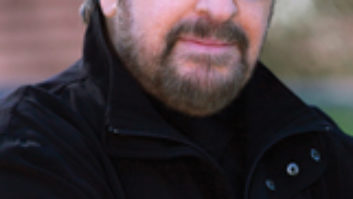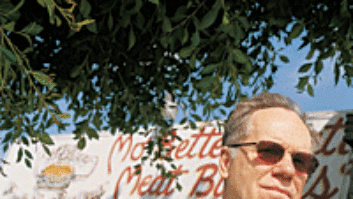Shelton Hank Williams III has been bucking the Nashville way of doing business since he signed his first record deal with Curb in the late ’90s. Like his famous father and grandfather, Hank III has blazed his own trail; his music shifts between recordings of pure honky-tonk, pure metal and something in between that he calls “hellbilly.”
Hank III’s latest double-CD release, Straight to Hell (BRUC Records), keeps to the dark side of country music. Disc one, as he explains it, “is us trying to do it right, using the players and getting the tones. Disc two is more an ambient disc. It’s a 42-minute track that goes back to me and this old Panasonic tape recorder my grandmother gave me that I still use to this day and a bunch of sound effects.”
Whereas the vast majority of today’s country music artists demand pristine and polished audio tracks, Hank III aims for vibe and personality. Rather than head to one of Music Row’s best-known studios, he and musical compatriots Joe Buck and Andy Gibson took up residence in an east Nashville home with a Korg D1600 digital recording workstation and got to work.
“It’s just three guys that don’t have any degree in recording or understand how it works doing their best,” Hank III reports. “We were all just doing what we thought halfway sounded good.” The trio showed up at the house every day for a month, working into the wee hours; as one person was playing the other would run the D1600.
Hank III raves about the now-discontinued Korg product that he uses to write and record: “When I was on the road [playing bass] with Superjoint Ritual, it would be like wake up, go into whatever room we’ve got, plug it in and start ripping out,” he says. “I’m a true believer that every independent band or do-it-yourselfer should have a machine like this.” The mobile workstation boasts an uncompressed 24-bit, 44.1kHz range with 24 channels and an 8-bus, 16-fader mixing surface.
The room where the vocals, guitars and bass were recorded for disc one was a relatively large one, with 15-foot ceilings. While there was no official baffling, Hank III reports that they recorded the vocals and acoustic guitars tucked in a corner. In keeping with the minimalist approach, few microphones were used during those tracking dates and just three kinds: Shure SM7, SM57 and KSM32. Hank III sang into the SM7, used the 57 on his acoustic guitar and kept a KSM32 going at all times to capture room vocal and guitar tracks that were later blended in.
Getting tones from the stand-up bass was a bit of an issue, Hank III says, because there was no controlling the room ambience. That was solved, in part, with Hank III twisting a knob on the D1600, checking the sound as it played on his home stereo system, which includes a Paradigm subwoofer, and then returning to finish the track. “We were trying to keep some of the click of the stand-up bass and trying for it to not sound too scary on the woofy end,” he says. A 57 was placed just above the bridge of the bass, one just below, and then one KSM32 slightly off to one side and another down a hall about 15 feet.
Any other type of instrument — dobro, fiddle, pedal steel — was miked with a 57 and run straight into the D1600. Indeed, other than the mic pre’s that are present in the D1600, no other outboard gear was used on the project.
Hank III opted to go into a proper studio to record drums, however, and he turned to James Lightman, who works out of The Track House (his studio) and Platinum Lab in Nashville. “It wasn’t a fancy setup,” Lightman reports. “It was basically 421s on the toms, a D 112 on the kick, and we used a Yamaha Sub-Kick, which has a lot to do with the low-end punch on the record.” He also used KSM44s as overheads and had a pair of Groove Tubes mics placed 10 feet or so in front of the kit to get room tones.
Balancing that deep low end against the stand-up bass offered some challenges for Lightman. “The stand-up is a little harder to tame than an electric, and you want to get the definition,” Lightman explains. “Part of his sound and part of the whole vibe of the record is the actual slapping on the bass, which is very percussive itself. There are a lot of songs where there are no drums, the bass is playing a walking bass line with the slapping in between and it sounds very percussive. So the interesting part was matching the drums and the bass and getting those to work as a unit.”
Lightman became an integral part of the production team on Straight to Hell. “After we recorded everything, I wanted — I hate to say this — a sober ear to listen to it,” Hank III says with a bit of a laugh. “The three of us were doing the best that we could and I wanted to get someone else’s input and help do a couple little things.”
To get the tracks ready for the drums to be added and for mixing, which he handled mostly at The Track House, Lightman dumped everything into Pro Tools and did stem mixes on an SSL 6048 and then put it back into Pro Tools for some further tweaks.
The album is light on effects. “All of the reverb that you hear on the vocals is natural,” Lightman reports. “There is not a drop of digital reverb. There are delays that are very obviously delays, but all that room ambience is the KSM32 that was across the room. That was very carefully blended in. There were three or four tracks on every vocal take, which had to be treated as one take. We locked the tracks together, and all the edits were done together.”
One of the vocal tracks that Lightman and Hank III turned to was a distorted vocal that was recorded into the D1600 dry and then dumped to Pro Tools. “Then I would run a stereo signal out of Pro Tools back into his Korg and he would set up a distortion patch on his Korg,” Lightman says. “We recorded the distortion part of it back into Pro Tools and mixed the distortion stereo track in with the dry vocals. That way, we were able to get a good blend of distorted and clean vocals.”
Another challenge was cleaning up the bass tracks. “The acoustic bass is not a real high-quality instrument,” the mixer says with a laugh. “It had more duct tape than wood on it, and the A string was about 11 dB softer than the D string, and the G string was so low in level that I don’t think it got used in the whole record. We had to do a lot of editing to a lot of those tracks to get the volume consistent. The playing was great, but the instrument had a big difference in terms of the strings. That was one thing that we had to really work out.”
The second disc includes the song “Louisiana Stripes” and a 42-minute track that Hank III and Lightman created in Pro Tools by editing together songs that Hank III had recorded in the past with an odd assortment of phone messages, an eclectic range of sound effects and room ambiences. “It’s stripped down and bare — me and my guitar and my tape recorder,” Hank III says. “There is a certain edge that I like about those recordings.”
What made Lightman’s job easier while working on both discs was the fact that Hank III had a clear plan from the beginning. “He’s got an incredible vision,” Lightman says. “I think he knew what he wanted before we started recording anything, and as the project progressed, I saw where he was going. It felt like it all fell together pretty easily.”




